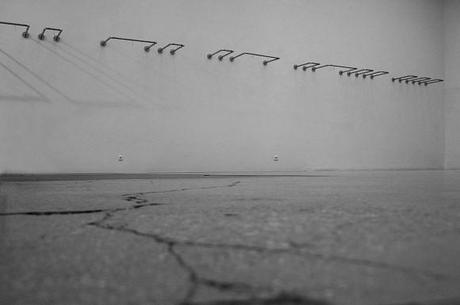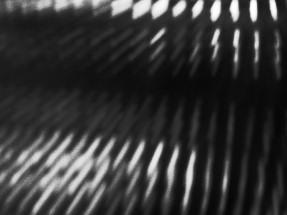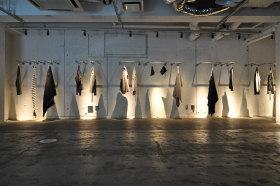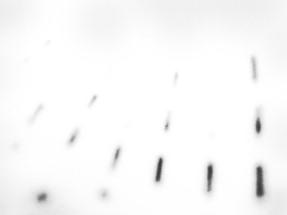I’ve wanted to Blog about this for a while now! Enjoy this fantastic piece by SCOUTE. Based on Luca Laurini, the designer behind “Label Under Construction” and his quest to send messages between a garment and its audience.
This is Laurini’s most painstakingly thought out and crafted project to date and it gives a fresh meaning to the used up phrase “the medium is the message.” – Scoute
Entire article and photos are property of www.scoute.org.
Enjoy!
Signals by Luca Laurini
By Eugene Rabkin

Luca Laurini, the designer behind Label Under Construction, has spent a number of years making intricately constructed clothes. But at some point this was not enough. What he wanted to do was make the clothes speak. The idea behind his new project, Signals, was to share messages with his audience.

For any man of culture, be it an artist or an intellectual, sharing cultural wealth is an instinct. We all have a desire if not to be validated in our worldview, then at least to be understood. This is why writers write and artists paint. Often, it is simply an overwhelming yearning to say something and, preferably, to be heard. But while the writer has words and the painter has images, a fashion designer is put at a disadvantage by his medium. To reflect one’s world via fabric and scissors is no easy task, but one that a mind as obsessed with design as Laurini’s was more than happy to undertake.
“The deepest concept in making this project was my desire to send out subliminal signals,” said Laurini. “These signals are linked to the intrinsic significance of each word, whether it’s an acronym, aphorism or a poem. Concepts like corrosion, laceration, the opposites, have an important significance, linked to us, to our society, and to our daily lives.”

Laurini is not one to take shortcuts in design, so merely writing slogans on clothes was out of the question, and even though English is becoming the Esperanto of the modern world, it is not common enough. Besides semiotics, the other problem that Laurini had to solve was the use of limited space, that of the garment. The solution was to use the Morse code – universal and short. “Morse code interested me a lot, firstly for the historical reason. It was the first universally accepted way of shortening communication,” said Laurini. The duality of the code, the external, visual component, and the internal, one that creates meaning,
also attracted him,

“It is fascinating that this code, graphically, just based on dot and line, can translate meaning in a minimalist way. For rendering language into a piece of fabric or a garment, not only its meaning is important, but also the graphic element that provides the meaning.”
But the real task for Laurini was to combine the language and the clothes into a whole, to inextricably intertwine them. In essence, the language becomes the language of clothes. Therefore, for example, he took Nietzsche’s aphorism from Thus Spake Zarathustra, about the eternal cycle of creation and destruction and cut it with the laser into the lining of the jacket made from old recycled fabric. Another aphorism, by Jonathan Swift, “Vision is the art of seeing things invisible” is incorporated into the jacquard pattern of the identical color town that only becomes visible under ultraviolet light.
Other methods Laurini used give words their physicality. They incorporate the language as a system of signs for naming the things with the things themselves. Accordingly, the words “Continuous Wave” are manifested by knitting the acronym “CW” using a wave knit pattern on a stole and a scarf. The combination of the words “Laser Embroidery” and their acronym are cut by a laser into a dress shirt, and the letters of the word “Corrosion” are recreated on a sweater by disintegrating the natural part of the yarn with acid, while leaving the synthetic part intact. Lastly, the concept of decay is reflected in the technique of laser laceration. It is used to emphasize the way fabric wears off at certain points if a garment is worn too long. The words “laser laceration” are incised by laser along the collar and cuffs of a dress shirt to give it a worn-in look.


The messages are broken down into four categories – acronym, poetry, aphorism, and words. “Acronyms, used today to shorten anything, are, in themselves, carriers of messages. The aphorisms, which are more explicit, like those of Nietzsche, Peale and Swift are very important from a philosophical point of view, and finally the poem by Merini lends a touch of poetry so often lacking in real life,” said Laurini. There are also four ways the code is incorporated into the garments – by knitting, cutting with a laser, using UV-sensitive yarn and corroding the fabric with acid. Each garment will come with a folder that recreates all the messages in a grid. This is Laurini’s most painstakingly thought out and crafted project to date and it gives a fresh meaning to the used up phrase “the medium is the message.”




